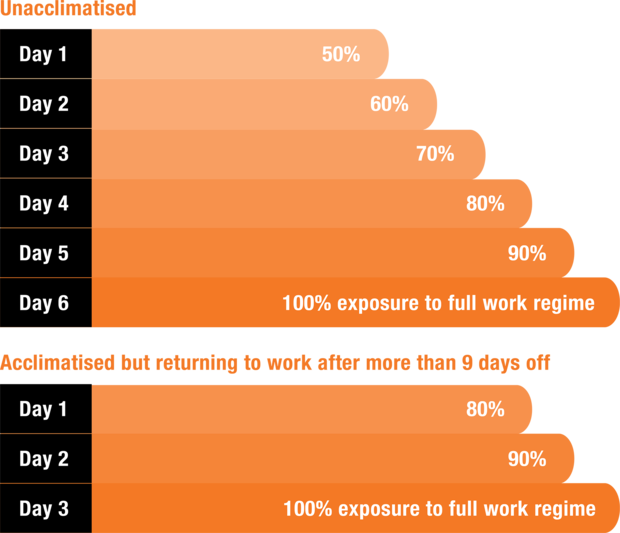On 31 March 2022, the Work Health and Safety (WHS) laws replaced the health and safety elements of the Mines Safety and Inspection laws. For information visit www.demirs.wa.gov.au/whs
All health and safety notifications, forms and guidance for mining and petroleum has moved to the WorkSafe website
What can heat stress lead to?
A combination of environmental influences such as air temperature, radiant heat, humidity and air velocity when coupled with metabolic heat generation and effects of clothing, may result in heat strain.
Early symptoms include increased sweating and heat rash, while mild heat illness includes fatigue, dizziness and cramps. Heat exhaustion is a mild form of shock with symptoms including extreme weakness or fatigue, uncoordinated action giddiness, nausea, headache and a weak rapid pulse.
Heat stroke occurs when the body’s thermoregulatory system has failed to prevent core body temperatures rising to critical levels above 40°C. Symptoms include lack of sweating and hot dry skin, irrational behavior, loss of consciousness and convulsions
Heat stroke may result in permanent damage to the brain and other vital organs; death may occur.
Heat stress – sum of environmental influences (air temp, radiant heat, humidity, air velocity) that, when coupled with metabolic heat generation and effects of clothing, may result in heat strain.
Heat strain – physiological response to heat stress on the body.
The Occupational Safety and Health Administration has a fact sheet on Protecting workers from the effects of heat.
Workplace factors
Working in high heat environments can put workers at risk of impaired performance, heat illnesses and heat stroke. These effects are not only due to geographical location (i.e. high summer temperatures in the north and inland areas of the State). Other workplace factors include:
- working in confined workplaces without adequate ventilation
- working where there is direct exposure to solar radiation
- working in hot and humid conditions
- work performed in the vicinity of hot sources such as furnaces, heaters and ovens
- heavy physical work in moderately hot and humid conditions (e.g. such as in some underground mines)
- work situations where protective clothing has to be worn
- unacclimatised workers.
Impaired performance and ill health may result in poor decisions and unsafe acts that lead to accidents.
Managing the risk
Risk factors
Environmental and individual risk factors should be assessed to determine the consequences of thermal stress that may affect the health of workers.
Following the risk assessment, the employer should implement control measures to reduce the risks and a system to evaluate heat stress (load) on workers.
The UK Health and Safety Executive has produced a heat stress risk assessment resource
The risk assessment should address the nature of the work as well as:
- environmental risk factors
- high heat and humidity,
- direct sunlight,
- confined spaces with little air movement while wearing protective clothing,
- heavy physical work in hot, humid conditions, such as in an underground mine
- the vicinity of heat sources such as furnaces, kilns, ovens and heaters
- individual risk factors
- degree of acclimatisation
- age (particularly over 60 years)
- fitness (including weight)
- hydration level
- medical conditions (e.g. diabetes and cardiovascular disease)
- use of alcohol and other drugs.
Indices of heat strain
There are a number of heat strain indices. Heat stress factors such as temperature, humidity, radiant heat and air movement can be measured and used to help calculate the wet bulb globe temperature index (WBGT), one of the more commonly used heat strain indices.
Engineering controls
Engineering controls include the use of ventilation such as fans, blowers, chillers. Air conditioning can be used in work areas such as crib rooms and in vehicles.
During field work, insulation or shielding such as tents or shade can be provided.
Administrative controls
Examples of administrative controls include:
- training and educating workers about control measures and recognising the effects of heat stress
- worker assessment and monitoring
- setting patterns of work
- acclimatisation schedules, particularly for new staff and after extended leave
- encouraging self-pacing of work
- maintaining hydration by replacing lost fluids (e.g. drink more water, juice, sports drinks or other non-alcoholic drinks).
Consider using selected personal protective equipment (PPE) such as ice or cool vests.
Assessment and monitoring
Medical surveillance may be required for some workers. This will help to determine general fitness, the presence of medical conditions and use of medications that may predispose a worker to heat strain.
Workers at risk of heat strain can be monitored at the workplace for signs of heat illness and to ensure work?rest and hydration regimes are followed.
Monitoring may also include assessment of:
- recovery heart rate times
- oral temperatures
- end-of-shift weight loss (to determine level of dehydration).
Related information
Please refer to the following links:

